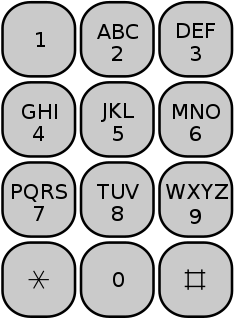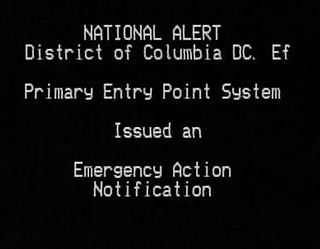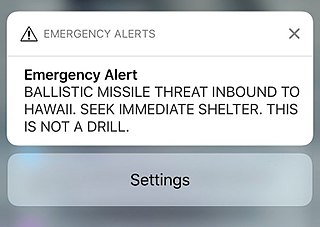
SMS is a text messaging service component of most telephone, internet, and mobile-device systems. It uses standardized communication protocols to enable mobile devices to exchange short text messages. An intermediary service can facilitate a text-to-voice conversion to be sent to landlines. SMS was the most widely used data application at the end of 2010, with an estimated 3.5 billion active users, or about 80% of all mobile subscribers.
The Session Initiation Protocol (SIP) is a signaling protocol used for initiating, maintaining, and terminating real-time sessions that include voice, video and messaging applications. SIP is used for signaling and controlling multimedia communication sessions in applications of Internet telephony for voice and video calls, in private IP telephone systems, in instant messaging over Internet Protocol (IP) networks as well as mobile phone calling over LTE (VoLTE).

An emergency position-indicating radiobeacon station is a distress radiobeacon, a tracking transmitter that is triggered during an accident. These are detected by satellites. The system is monitored by an international consortium of rescue services, COSPAS-SARSAT. The basic purpose of this system is to help rescuers find survivors within the so-called "golden day" during which the majority of survivors can usually be saved.
Specific Area Message Encoding (SAME) is the protocol used to encode the Emergency Alert System (EAS) and NOAA Weather Radio (NWR) in the U.S. and Weatheradio Canada in Canada. It is also used to set off receivers in Mexico City and surrounding areas as part of the Mexican Seismic Alert System (SASMEX).

NOAA Weather Radio is an automated 24-hour network of VHF FM weather radio stations in the United States that broadcast weather information directly from a nearby National Weather Service office. The routine programming cycle includes local or regional weather forecasts, synopsis, climate summaries, synopsis or zone/lake/coastal waters forecasts. During severe conditions the cycle is shortened into: hazardous weather outlooks, short-term forecasts, special weather statements or tropical weather summaries. It occasionally broadcasts other non-weather related events such as national security statements, natural disaster information, environmental and public safety statements sourced from the Federal Communications Commission's (FCC) Emergency Alert System. NOAA Weather Radio uses automated broadcast technology that allows for the recycling of segments featured in one broadcast cycle seamlessly into another and more regular updating of segments to each of the transmitters. It also speeds up the warning transmitting process.

Mobile telephony is the provision of telephone services to phones which may move around freely rather than stay fixed in one location. Mobile phones connect to a terrestrial cellular network of base stations, whereas satellite phones connect to orbiting satellites. Both networks are interconnected to the public switched telephone network (PSTN) to allow any phone in the world to be dialed.

An emergency population warning is a method whereby local, regional, or national authorities can contact members of the public en masse to warn them of an impending emergency. These warnings may be necessary for a number of reasons, including:

Mobile television is television watched on a small handheld or mobile device. It includes pay TV service delivered via mobile phone networks or received free-to-air via terrestrial television stations. Regular broadcast standards or special mobile TV transmission formats can be used. Additional features include downloading TV programs and podcasts from the Internet and storing programming for later viewing.
The National Warning System (NAWAS) is an automated telephone system used to convey warnings to United States-based federal, state and local governments, as well as the military and civilian population. The original mission of NAWAS was to warn of an imminent enemy attack or an actual accidental missile launch upon the United States. NAWAS still supports this mission but the emphasis is on natural and technological disasters. Organizations are able to disseminate and coordinate emergency alerts and warning messages through NAWAS and other public systems by means of the Integrated Public Alert and Warning System.

Wireless Emergency Alerts, is an alerting network in the United States designed to disseminate emergency alerts to mobile devices such as cell phones and pagers. Organizations are able to disseminate and coordinate emergency alerts and warning messages through WEA and other public systems by means of the Integrated Public Alert and Warning System.

An Emergency Action Notification is the national activation of the Emergency Alert System (EAS) and can only be activated by the President or the President's representative. The Emergency Broadcast System (EBS) also carried the Emergency Action Notification. It has never been used by any President since its creation.
The Integrated Public Alert and Warning System (IPAWS) is an architecture that unifies the United States' Emergency Alert System, National Warning System, Wireless Emergency Alerts, and NOAA Weather Radio, under a single platform. IPAWS was designed to modernize these systems by enabling alerts to be aggregated over a network and distributed to the appropriate system for public dissemination.
An emergency communication system (ECS) is any system that is organized for the primary purpose of supporting one-way and two-way communication of emergency information between both individuals and groups of individuals. These systems are commonly designed to convey information over multiple types of devices, from signal lights to text messaging to live, streaming video, forming a unified communication system intended to optimize communications during emergencies. Contrary to emergency notification systems, which generally deliver emergency information in one direction, emergency communication systems are typically capable of both initiating and receiving information between multiple parties. These systems are often made up of both input devices, sensors, and output/communication devices. Therefore, the origination of information can occur from a variety of sources and locations, from which the system will disseminate that information to one or more target audiences.
The Mobile Emergency Alert System (M-EAS) is an information distribution system that utilizes existing digital television spectrum and towers to provide information in emergency situations using rich media. The system can push text, web pages, and video to compatible equipment, such as mobile DTV devices. M-EAS is different than existing 90-character Wireless Emergency Alerts (WEA) available to cellphones, as it allows video, audio, photos and graphics, too.

OpenBroadcaster is a web-based, open-source system to run community radio and television broadcast transmitters with a simple web interface.

The National Public Alerting System, branded as Alert Ready, is the national warning system in Canada. The system consists of infrastructure and standards for the presentation and distribution of public alerts issued by government authorities, such as weather emergencies, AMBER Alerts, and other emergency notifications, by all broadcasters and Last mile distributors in the affected region, including television stations, radio stations, television providers, and LTE mobile networks in the affected region.

The Nokia Asha 310, also known as the Nokia Asha 3010 or the Nokia ASHA 310 RM-911, was released in March 2013. It is the first in the line of the Asha range of phones to have dual subscriber identity module (SIM) slots and Wi-Fi connectivity. It was a reinvention of the Asha range to remain competitive with new Android devices. It cost $102.00 at its launch date. It has a touchscreen, comes with either a 2 or 4 GB micro SD card, and has 64 MB of RAM, a 2 MP camera and a battery that can last up to 600 hours in standby mode. The phone can play music for up to 54 hours or video for up to 9.5 hours, and has a maximum of 17 hours talk time (2G).

On Saturday morning, January 13, 2018, a false ballistic missile alert was issued via the Emergency Alert System and Commercial Mobile Alert System over television, radio, and cellphones in the U.S. state of Hawaii. The alert stated that there was an incoming ballistic missile threat to Hawaii, advised residents to seek shelter, and concluded "This is not a drill". The message was sent at 8:07 a.m. local time. However, no civil defense outdoor warning sirens were authorized or sounded by the state.



















